How to Install Tire Chains on a Semi Truck
This post may contain affiliate links. You can read the full disclosure policy, which is pretty dull, but here it is.
Step by step instruction on chaining up a big rig.
If you are a truck driver, there may be times in your trucking career, you 'may' be required to chain up your truck.
If you run in areas that don't get snow or icy conditions, consider yourself fortunate!
However, as a professional truck driver, you may wish to acquire this skill as you may find yourself in another job someday and it maybe necessary to chain up!
For example, there could be chain laws posted in an area where you're traveling or your truck could be stuck.
Method One: How to Install Single Chains
This is how to 'hang chains'.
This method involves the driver actually draping the chains over the wheels.
If your chains are very heavy, you may wish to use the second method.
Step One – Lay Chains Flat – Inspect
- Test, fit and practice on dry ground and in the daylight.
- Do NOT let your first chain up be in the dark, in a snowstorm, halfway off the active lane.
- The first step is simply place the chains flat out on the ground. I've found this is the best way to start.
- This is a good way to see that the chains are in good order and there is no damage. Then you'll know they are going to do the job you need them to. Just because you have your chains doesn't mean they are in good working condition.
- I personally find this method easier. It only takes a few minutes to lie them on the ground, inspect them and them drape them over the wheels (if everything is in good working order)
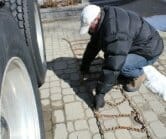
Related > CDL Skills + Knowledge Every Professional Driver Should Know
Step Two – Drape Chains Over Wheels
When I'm satisfied the chains are in good working order, I pick up the chain on the side further away from me.
Spread the chains evenly over the surface of the tire. You already know they fit, as you dry fitted them.
I advocate for dangling an inch or two to one side of the tire, front or back and tucking the rest to the other side.
I pull and move the chains across the tread to get it centered as much as possible across the tread face and worked into the grooves of the tread. Tug hard.
Do both sides and make sure that you match which end has the short chains as this is the direction that you will move the truck.
- Hooking up on the ground can get messy. If you do take an old piece of a mudflap or a piece of plastic cleated floor runner to use as a word surface.
- When I pick up the chain, I grab it around the middle.
- I then pick up the chains and drape it over the wheel, so the chain is distributed as evenly as possible over the wheel.
- Be sure that the clips that secure the the cross chains are facing outward, in order that they don't rub on the sidewall of the tire.
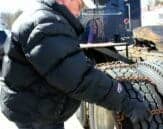
Step Three – Hook the Inside Clip
- Then, I reach in behind the duals to hook the inside clip of the tire chain.
You may have a tool that you like to do this job. But, I find the fifth wheel hook a handy tool for this step. I use it to hook the inside clip, between the tires.
The great thing about using the fifth wheel hook, is it's a handy tool that most truck drivers have with them.
- Take the fifth wheel hook and grab the inside clip between the wheels.
- I move the mudflap out of the way if necessary and reach in with the hook and grab the hook from the far side. I pull it forward and clip the inside clip with the chain, so it's fastened on the inside of the dual now.

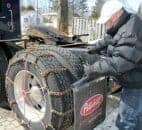
Step Four – Tighten the Cams
The cams are a simple configuration and they are relatively easy to hook up.
The purpose of the cams is to fasten the entire chain down at the end of the process.
- On the front face on the tire, I tighten the cams up snugly with an adjusting wrench. The wrench is inserted into the cam and turned to increase the tension in the chain.
- Try to tighten each cam, to help snug up the chain.
- You probably won't be able to get a turn from each cam. It's most likely you'll be able to get one turn on a few of them.
-
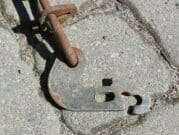
Closeup of Fastening Clasp -
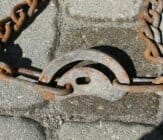
Closeup of Adjustment Cam
For extra security and tension for the chains, you can use regular bungee straps.
However, I bought a specialized set of tire straps, in Wyoming at a truck stop. They are very handy for securing them.
- The rubber straps can be hooked onto the chain, evenly spaced to secure and tighten up the entire configuration.
- When attaching the spider bungies, have the hooks facing outward, not inward. The hooks may rub and damage the outside of the tires, if the chains on for any length of time
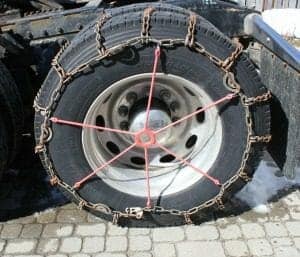
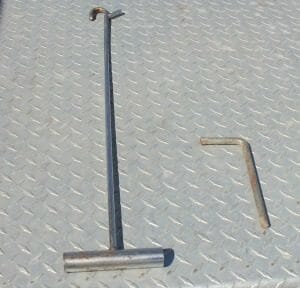
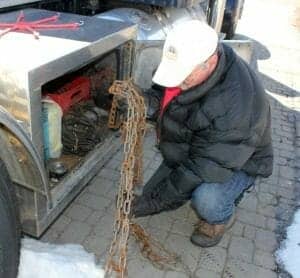

Method Two: How to Install Single Chains
This method is where the driver lays the chains out, and installs them without actually picking them up and draping over the wheels.
- Pick a safe spot. For example, in B.C., there's a designated chain up area on most highways, so you don't have to risk doing this roadside.
However, don't park in a chain up area, unless you are chaining up.
Pull in, select your spot, being courteous to others.
- Turn on 4 ways. Pull up slowly.
Do a couple of back and forth maneuvers to pack down the snow/move the slush. If you've been on the highway in snow, stop, kick off your mud flaps then pull forward or back a bit out of your snowpile.
If you have a snow shovel, clear off a bit ahead and beside the tire/axle you are chaining, or a runway to lay your chains.
- Lay out the chains. Take your chains, lay them out in the spot you've just cleared. Hopefully you've checked your chains after their last use, and put them away properly so you can just grab them and skip this step.
- Straighten the chains.
- Check your main rails (side chains) for bent/worn links and remove any kinks.
- Check all cross chains for damage or wear and remove any kinks.
- Check your end fittings for bends and wear.
NOTE: Pay special attention to the cross chains near each end of the fittings. These get easily twisted (like a knot) where you need to spin one end thru the other to undo the twist. This is easier to spot on V-bar or studded than on regular cross chains.
- If you have V-bar or studded, it's easy to tell which side is the outside.
- If you have regular, check the link that attaches the cross chain to the rail, to ensure the hooks face away from the sidewall.
Note that cams on singles should be to the outside.
On most triples, you have cams on the inside and the outside rail (not the center).
- Ensure that all the cams are in the opened position (with the most slack).
On my chains that means the round part of the half moon faces towards the hub/center of the wheel.
If you want your chains 'upside down' (v-Bar or studs down) or right way up. You will either be flipping the cam onto the tire (from upside down) or draping it over (from right way up).
For triples, the easiest way to do them is to lay them with the traction side up, then fold the inner side of the chain over the outer, so it is only one tire wide. Drop the double up chain over the outside tire and flip the top chain over the inside. This is far neater and easier.
- Fasten connectors. Now start fastening the connectors.
- On triples, do the CENTER hook first.
- On singles, do the inside.
- Tighten. Turn as tight as possible. Maybe you can skip one or more links.
If you have test fitted the chains, you should have an idea of which link you need to hook to initially.
Note that tire wear will lengthen your slack in the chain. New tires will shorten the slack and open should tires have more slack than closed shoulder.
- Too much slack. Pay attention to how much loose chain (slack) you have. Will it flail around and start causing damage?
What to do about chain slack.
There's 2 ways to deal with slack chain.
- Keep some zip ties handy and tie them to adjacent links,
- Or tuck them back through either the hook or the boomer when you hook them up.
- Do the outside hook or boomer.
- On triples, the order is center, inside, outside.
- Go as tight as possible. Then grab your cam tightening tool (KEY) and crank each cam that you are able.
Seat the Chains
- Jump back in the cab. Move about 50′. You could go 50′ in one direction or 20′ back and forth 3X. Space can be limited in a chain up area.
- What this does is seat the chains down into the tread of the tire. This is more important on open shoulder tires than dclosed.
Note: This is much easier and safer to do than stopping again in another aread than where you are alread set up.
Jump back out and go back and forth and look at the chains.
Pull on them and see if there is any slack either across the cross chains on the face of the tread or in any of the side chains (inside, outside and middle if appropriate). If there is, tighten any remaining cams or if you can undo an end, and take one more link out, do it.
It may mean undoing all of the cams to loosen them up, take out a link and then re-tighten them all again.
The goal here is to get the chains as tight as possible.
Well -maintained chains will only break if they are loose, or if you abuse them.
When I initially hook up my chains, I already know which link I need on the inside (or middle and inside) and loop any excess chain at that point.
On the outside cam, I leave all the links loose until I have re-tightened after pulling forward and back to seat the chains in the tread. Zip ties or looped through the hook/boomer is good. This means that nothing will flail around and tear out a rub rail, fender air line, brake line or do other damage.
I use good cam chains, which fit my tires, so I don't need spiders or bungees. If you do need them, use them. The goal is to take as much slack out of the chain as possible. Make sure the rubbers are in good shape or they become useless scrap on the roadways.
When Ready to Leave
- Turn off the radio, window down party way and LISTEN as you pull out. You can hear how the chains sound. You can feel how they ride too. It will be bumpy. Once you do it often enough, you can tell by feel and sound if you are hooked up correctly. I can hear my chains 'sing' and know how they should sound in either compact snow, fluffy snow, slush or on dry spots.
- If you suspect you have a loose chain or a link breaks, slow down and stop safely out of the travel lane before you do damage.
- In the rare circumstance where you are committed, be aware that stuff will get torn up by a loose chain or it will come off and be a hazard for others. This is bad either way.
Unchaining
So assuming you've made it up or down the slippery hill.
Use a chain off area, parking lot or other safe spot, with 4 ways on.
Jump out and remove any bungeess/spoders that you used for tension.
Undo the cam. Sometimes you don't need them all to unchain. Just undo the hook or boomer on the outside, and hook on the inside. Pull the loose ends of the chain to the side away from the tire and path of travel on both sides.
Move the truck forward or back to come off the chains.
Tire Chain Storage Tips
** Examine the chains NOW before putting them away.
- Open or loosen any remaining cams that you didn't loosen. Look for broken links, twists, bent fittings et. Take note to fix or replace if needed.
Knock whatever you can off the chains, snow , slush etc.
- I fold my chains to put them away. I pull them back straight, traction side up, fold them in half and put them away as clean as I am able.
- No knots, twists, damage.
- Then your equipment will be ready for use the next time.
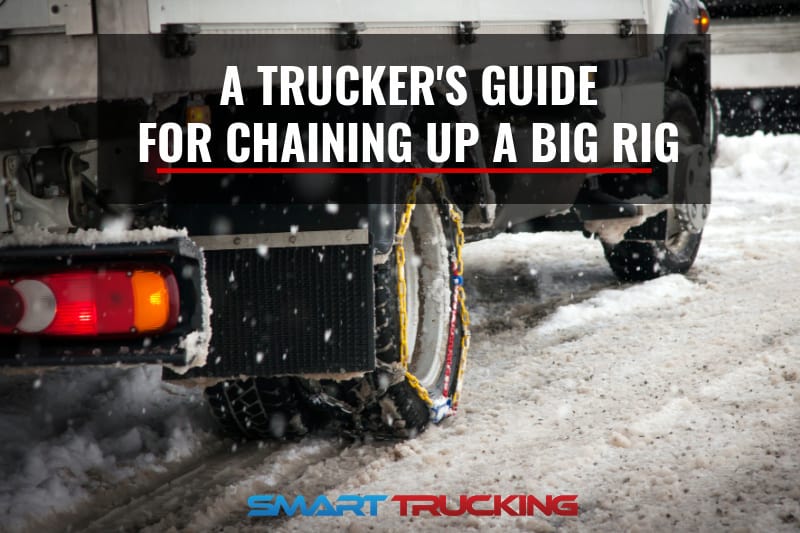
Watch the Video Version – How to Chain Up a Big Rig
Style of Chains
- Regular Chains – Just a normal cross chain
- Studded – 2 prongs/plugs sticking out (good for ice)
- V-Bar – Preferred. Good for traction, moderate price increase over regular style. These have a nice 'bite' ability, work well on ice or compact snow and they are fairly sturdy for wear and tear. When they wear down, they function as re-enforced regular chains.
What Are Chains Made Of?
There are different grades. Cheap, regular steel, plated and alloy. Regular steel is preferred although they will rust. This is fine as long as it does not wear through the chains.
Alloy lasts longer, but they are expensive.
The Hardware
Cams
- There are cheap chains 'without' cams. They are side chains and hooks. Not recommended.
- The number of cams can vary, but a decent set of 11R22.5 or 11R24.5 (most common size) will have at least 4 cams.
- More cams is better.
End Hardware
- End hardware is also important. YOu can go with plain old hooks, or Boomers. The set in the video are 'Medium Boomer' – The end that hooks through a chain loop and folds back around.
- The longer the boomer, the more tension you can impart, making tightening the chain easier.
- Short, medium and long boomers are all available.
- Style of hold-back varies, some are simple clips and others are triangular.
Testing your chain installation.
When I have all the tire chains installed that I require and well secured, I'll drive perhaps an 1/8th of a mile.
I then stop the truck, get out and double check everything to make sure the chains are secure and properly in place.
By driving slowly for a short distance, it's a good way to test the security of the chaining job you just did.
The last thing any truck driver wants is for the chains to come off while driving. They can cause serious damage to the truck if they come loose.
Related > How to Slide the Fifth Wheel on a Big Rig
Do lots of mountain driving?
For truckers who get regular runs in the mountains, here's something to consider.
I would not recommend half fenders on the truck. Quarter fenders are easier to deal with when chaining up.
It's much easier to drape the chains over the wheels with 1/4 fenders rather than squeezing the chains up under the half fenders.
When to remove the chains.
Tire chains are designed to run on snow. Once you hit wet or dry pavement, it's time to stop and remove them.
Can I travel any speed with chains on?
A truck with chains installed isn't meant to travel fast.
They are meant to get the truck through slippery and dangerous spots.
At excessive speeds, over 30-40 m.p.h., they can break away, fly loose and do serious damage to the equipment.
They can also break loose and do damage to other vehicles around the truck.
What are the chain requirements?
Each state and province has their own specific requirements for their chain laws. Be sure to check where you are traveling ahead of time, in order that you are prepared, in case the chain laws are in effect.
- Some states/provinces only require that a truck carry them
- Some indicate that it's necessary to chain up under certain conditions when chain requirements are in effect.
Be aware of what the requirements are, or else you'll be forced to wait out the road closures.
Related > The Best Trucking Companies to Work For – U.S.
How many chains do I need?
The maximum number of tire chains to carry is 6.
However, six tire chains for a tractor trailer can add up to a lot of weight.
When you put them away in your truck storage box, be aware that you've potentially gained almost 1000 pounds in weight as a result.
Remember this adds to your gross vehicle weight, so be aware of that before you pick up your next load.
Types of chains.
- Singles — I used single chains in the demonstration. A single tire chain will cover one tire.
- Doubles — Double chains will wrap around both tires.
- Triples — Triple chains will wrap around both tires but align in the middle to hook up between the duals, which helps to secure them.
Chain weight.
These bad boys (in the demo) are very heavy.
They are also awkward to install, store and handle.
The welded cleats on the cross-links gives them great traction, but also adds to the weight.
When you're carrying a full set of triple chains, you're carrying a lot of weight. It makes the truck difficult to maneuver, and they're especially tough to install.
To chain up or wait it out.
Unless you do lots of mountain driving, you're often better to just to wait it out.
If you're in California for example, I-80, you're better to sit in Boomtown and wait it out.
CalTrans does a good job of cleaning off I-80. By the time you invest the time and effort into chaining up your rig, you'd be better to just go in and have dinner and spend the night.
Attempting to go over the hill at night with a full set of chains, can be quite an adventure!
California sometimes requires chaining when the road is only wet. Remember, that's hard on your chains. In this situation, I'd recommend sitting and waiting for the road to reopen to regular traffic.
Practice. Practice. Practice.
Running the Coquilhalla and other more northern routes, as well as some FST's and occasionally residential type streets. When I tighten down my chains, I know that I'm good for 40-50 kmh on bare pavement, usually the start of the bottom of the Coq based on my chain material and the fact that I have them TIGHT.
I can go up to 70 kmh in the snow if it's either companct or fluffy. I don't recommend these speeds for anyone that doesn't know that they are doing or doesn't have experience in bad weather or with their truck , chains etc.
Everything needs to work right. I run with the radio off, window cracked open when I do this because you can 'hear' a problem.
Not a glamorous part of being a trucker.
Chaining up a big rig, is by no means one of the fun things about being a truck driver.
However, it can be a handy and necessary skill to know. Kind of a necessary evil.
Frequently Asked Questions
Chaining up a truck looks difficult and complicated. Is it hard?
The secret to any task as a professional truck driver is to educate yourself on the proper procedure no matter what the task. It can save you time and keep you (and others) safe.
Is now a good time to become a truck driver?
There are many advantages to becoming a truck driver. There are also downsides to a trucking career. Much depends on an individual's expectations of the job. The face of the trucking industry is changing now and changing for the benefit of the truck driver, as the shortage of qualified professional drivers grows exponentially.
How much is the fine for not carrying chains when it's mandatory?
The fine varies depending on which state or province.
Are all trucks in truck driver training schools automatic?
The move in the trucking industry is toward automatic semi trucks, but there are still some training schools and trucking companies which have manual transmission trucks.
Is 'over the road' trucking the best truck driving job?
Over the road or OTR trucking is not for just any truck driver. It can be difficult, grueling work, depending on what trucking company the driver is employed by.
How long does it take to throw on a set of singles?
In moderately adverse conditions, it should take about 10 minutes to hang a set of chains, once you've had some practice.
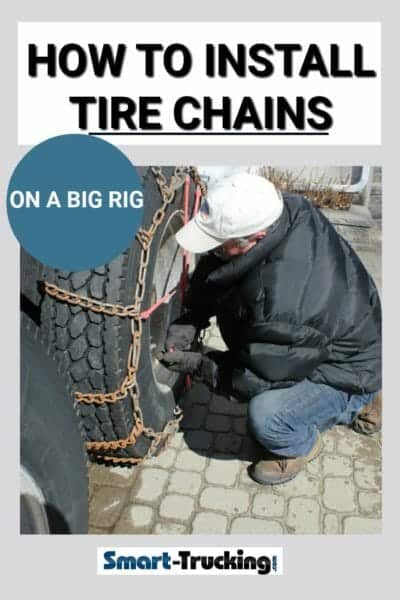
How to Install Tire Chains on a Semi Truck
Source: https://www.smart-trucking.com/chaining-up-a-big-rig/